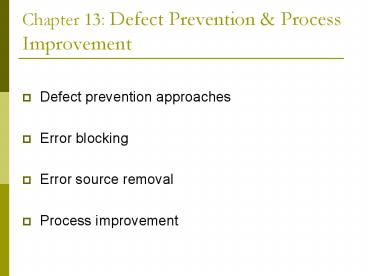Chapter 13: Defect Prevention & Process Improvement - PowerPoint PPT Presentation
1 / 15
Title:
Chapter 13: Defect Prevention & Process Improvement
Description:
Chapter 13: Defect Prevention & Process Improvement Defect prevention approaches Error blocking Error source removal Process improvement QA Alternatives Defect and QA ... – PowerPoint PPT presentation
Number of Views:309
Avg rating:3.0/5.0
Title: Chapter 13: Defect Prevention & Process Improvement
1
Chapter 13 Defect Prevention Process
Improvement
- Defect prevention approaches
- Error blocking
- Error source removal
- Process improvement
2
QA Alternatives
- Defect and QA
- Defect error/fault/failure.
- Defect prevention/removal/containment.
- Map to major QA activities
- Defect prevention (this chapter)
- Error source removal error blocking
- Defect removal Inspection/testing/etc.
- Defect containment Fault tolerance and failure
containment (safety assurance).
3
Generic Ways for Defect Prevention
- Error blocking
- Error missing/incorrect actions
- Direct intervention
- Error blocked gt fault injections prevented
- Rely on technology/tools/etc.
- Error source removal
- Root cause analysis gt identify error sources
- Removal through education/training/etc.
4
Defect Prevention Why and How?
- Major factors in favor of defect prevention
- Super-linear defect cost ? over time
- early faults chain-effect/propagation
- difficult to fix remote (early) faults
- in-field problems cost s? significantly
- Basis for defect prevention Causal and risk
analysis - Analyze pervasive defects
- Cause identification and fixing
- Risk analysis to focus/zoom-in
5
Defect Cause and Actions
- Types of causal analyses
- Logical (root cause) analysis by expert for
individual defects and defect groups - Statistical (risk) analysis for large data sets
with multiple attributes - Model predictor variables gt defects
- defects often as response variable
- Actions for identified causes
- Remedial actions for current product
- Preventive actions for future products
6
Common Causes/Preventive Actions
- Education/training to correct human
misconceptions as error sources (13.3) - Product/domain knowledge,
- Development methodology,
- Development process, etc.
- Act to remove error sources
- Formal methods, Chapter 15
- Formal specification to eliminate imprecision in
design/implementation. - Formally verify fault absence.
7
Common Causes/Preventive Actions
- Technologies/tools/standards/etc. (13.4)
- Based on empirical (statistical) evidence
- Proper selection and consistent usage
- More for error blocking than error source removal
- Process improvement (13.5)
- Integration of many factors in processes
- Based on empirical evidence or logic
- Define/select/enforce
- Both for error blocking and error source removal
- Cause identification often implicit
8
Education and Training
- People most important factor to quality
- - e.g., vs. impl. languages (Prechelt, 2000)
- Development methodology knowledge
- Solid CS and SE education
- Methodology/process/tools/etc.
- Product/domain knowledge
- Industry/segment specific knowledge
- Type of products new vs. legacy, etc.
- General product environment, etc.
- Means of delivery formal and informal education
on-the-job training.
9
Other Techniques
- Analysis and modeling research, predictive
models - Appropriate software technologies
- Formal methods Chapter 15.
- Clean room formal verification statistical
testing - Other technologies CBSE, COTS, etc.
- Appropriate standards/guidelines
- Misunderstanding / miscommunication ?
- Empirical evidence for effectiveness (Briand2001
Dijkstra1968)
10
Tools for Error Blocking
- Programming language/environment tools
- Syntax-directed editor / syntax checker .
- General tools for coding standards, etc.
- Other tools
- Design/code and version control
- Tools for individual development activities
- testing automation tools, see Chapter 7
- requirement solicitation tools,
- design automation tools, etc.
- General tools or tool suites for certain
methodologies, e.g., Rational Rose.
11
Process Improvement
- Process improvement gt defect prevention
- Selecting appropriate development processes
- Process characteristics and capability
- Match to specific product environment
- Consideration of culture/experience/etc.
- Process definition and customization
- Adapt to specific project environment
- Process enforcement and ISO/9000
- Define the process or say what you do"
- Follow the process or do what you say"
- Demonstrate evidence it was followed or show me"
12
Process Maturity for Improvement
- SEI/CMM work
- KPA (key practice areas) for each level
- Expectation maturity" gt quality"
- Focus on defect prevention
- Recent development CMMI, P-CMM, SA-CMM, etc.
13
Other process maturity workfor Improvement
- SPICE (Software Process Improvement and
Capability dEtermination) - International effort
- 3 goals
- Process assessment, industry trials, and
technology transfer - BOOTSTRAP 2 ESPRIT programme
- European Commission
- develop methodology for software process
assessment, quantitative measurement, and
improvement - validate it by applying it in a number of
companies
14
Quality Improvement Process
- QIP Quality Improvement Paradigm
- understand baseline
- intro. process change and assess impact
- package above for infusion into development
organization - GQM goals/questions/metrics paradigm for QIP
- goal-driven activities
- questions related to goals
- metrics to answer questions
- EF Experience Factory
- provides organizational support
- separation of concerns for product and process
- EF supports reuse of experience and collective
learning - form a feedback/improvement loop
15
Summary
- Key advantages
- Significant savings if applicable
- Important people factor
- Promising tools, methodologies, etc.
- Process improvement long-lasting and wide-impact
- Key limitations
- Need to know causes of pervasive problems
- Difficulties in analyzing complex problems
- Difficulties with changing environment
- Hard to automate
- Process quality product quality ??
- Comparison to other QA Chapter 17.































